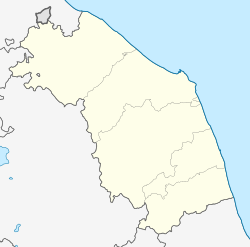Urbania
For the 2000 film, see Urbania (film)
Urbania | |
|---|---|
| Comune di Urbania | |
| Coordinates: 43°40′N 12°31′E / 43.667°N 12.517°E | |
| Country | Italy |
| Region | Marche |
| Province | Province of Pesaro e Urbino (PU) |
| Frazioni | Barca, Campi Resi, Campolungo, Gualdi, Muraglione, Orsaiola, Ponte San Giovanni, San Lorenzo in Torre, San Vincenzo in Candigliano, Santa Maria del Piano, Santa Maria in Campolungo, Santa Maria in Spinaceti |
| Area | |
| • Total | 77.8 km2 (30.0 sq mi) |
| Elevation | 273 m (896 ft) |
| Population (Dec. 2004)[2] | |
| • Total | 6,804 |
| • Density | 87/km2 (230/sq mi) |
| Demonym(s) | Urbaniesi, Durantini |
| Time zone | UTC+1 (CET) |
| • Summer (DST) | UTC+2 (CEST) |
| Postal code | 61049 |
| Dialing code | 0722 |
| Patron saint | St. Christopher |
| Saint day | July 25 |
| Website | www.comune.urbania.ps.it/ |
Urbania is a comune (municipality) in the Province of Pesaro e Urbino in the Italian region Marche, located about 80 km west of Ancona and about 40 km southwest of Pesaro, next to the river Metauro.
Urbania borders the following municipalities: Acqualagna, Apecchio, Cagli, Fermignano, Peglio, Piobbico, Sant'Angelo in Vado, Urbino.
It is a famous Ceramics and majolica production centre.
History
Originally known as Castel delle Ripe, it was a free commune of the Guelph party. In 1277 it was destroyed by the Ghibellines: rebuilt by the Provençal Guillaume Durand (1284), in that occasion it was christened Casteldurante. Later it was ruled by the Brancaleoni family. When the latter were ousted, the city offered itself to the Dukes of Urbino, which used the palace in the city as summer residence and had it restored by architects such as Francesco di Giorgio Martini. the last della Rovere duke, Francesco Maria II, is buried in the Ducal Palace of Urbania.
In 1631 it became part of the Papal States. Five years later it changed again name to the current one, in honor to Pope Urban VIII.
After World War II Urbania received the Bronze Medal for Military Valour for the deeds of its citizens during the partisan warfare.
Main sights
- Ducal Palace, housing a museum and a library with maps by Mercator.
- Chiesa dei Morti (Church of the Dead), with natural mummies from the Middle Ages and the Renaissance.
- The medieval walls.
Demographic evolution

Trivia
Urbania features as the main setting of Ci Siamo (ISBN 1-86391-109-X) a textbook for students of Italian used by many Australian students in the middle years of high school.
External links
- ^ "Superficie di Comuni Province e Regioni italiane al 9 ottobre 2011". Italian National Institute of Statistics. Retrieved 16 March 2019.
- ^ "Popolazione Residente al 1° Gennaio 2018". Italian National Institute of Statistics. Retrieved 16 March 2019.



